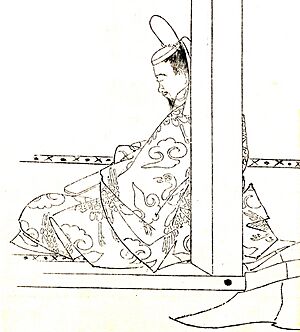Fujiwara no Kaneie facts for kids
Quick facts for kids
Fujiwara no Kaneie
藤原兼家 |
|
|---|---|

Fujiwara no Kaneie by Kikuchi Yōsai
|
|
| Daijō-daijin | |
| Personal details | |
| Born | 929 |
| Died | July 26, 990 (aged 60–61) |
| Nationality | Japanese |
| Children | Fujiwara no Michinaga |
| Parent |
|
Fujiwara no Kaneie (藤原 兼家, 929 – July 26, 990) was a very important Japanese statesman and politician during the Heian period. He helped lead the government and was known for his power. People also called him Hōkō-in Daijin and Higashi-sanjō-dono.
Contents
Kaneie's Rise to Power
Fujiwara no Kaneie served as a minister for several emperors. These included Emperor En'yū, Emperor Kazan, and Emperor Ichijō. He worked hard to gain influence in the imperial court.
Becoming a Top Minister
In 977, Kaneie's brother and rival, Fujiwara no Kanemichi, passed away. After this, Kaneie was appointed to a high position called Udaijin. This role was like a Minister of the Right. His cousin, Fujiwara no Yoritada, became the Kampaku (chief advisor) at that time.
Influencing the Emperor
Kaneie wanted to become the Sesshō (regent) for the emperor. To do this, he needed the current emperor, Kazan, to step down. Kaneie and his son, Fujiwara no Michikane, encouraged Emperor Kazan to leave the throne.
They told Emperor Kazan that the Imperial Regalia of Japan (special treasures of the emperor) were already with Prince Ichijō. This meant Kazan should not continue as ruler. Under some pressure, Emperor Kazan agreed to Kaneie's demands. He then went to the Gangyō-ji monastery.
Michikane, Kaneie's second son, went with Emperor Kazan. He pretended he would also become a Buddhist monk. However, when they arrived at the monastery, Michikane said he wanted to see his parents one last time. He left and never returned to the monastery.
Becoming Regent
When Emperor Ichijō became the new ruler, Kaneie achieved his goal. He was appointed Sesshō for Emperor Ichijō. This made him the most powerful person in the government.
Key Appointments and Roles
Kaneie held many important positions throughout his life:
- 969: He received the rank of Ju Sammi (従三位).
- 970: He became a Chūnagon, a middle-level councilor.
- 972: Kaneie was promoted to Dainagon, a higher councilor position.
- 978: He was named Udaijin, the Minister of the Right.
- 986: Kaneie became Sesshō for Emperor Ichijō. He also retired from his Udaijin role.
- 989: Kaneie was named daijō daijin, the highest government position.
- 990: Kaneie became very sick. He left his government jobs to become a Buddhist monk.
- July 26, 990: Kaneie passed away at the age of 62.
Kaneie's Family Life
Fujiwara no Kaneie came from a very influential family. His father was Fujiwara no Morosuke. Kaneie had four brothers: Fujiwara no Kanemichi, Fujiwara no Kinsue, Fujiwara no Koretada, and Fujiwara no Tamemitsu.
Wives and Children
Kaneie had several wives and many children. His family played a big role in Japanese politics for generations.
Fujiwara no Tokihime
His main wife was Fujiwara no Tokihime. She was the mother of several important children:
- 1st son: Fujiwara no Michitaka (953–995). He later became a Sesshō and Kampaku for Emperor Ichijō.
- 3rd son: Fujiwara no Michikane (961–995). He also served as a Kampaku for Emperor Ichijō.
- 5th son: Fujiwara no Michinaga (966–1028). He became a very powerful Kampaku for Emperor Go-Ichijō.
- 1st daughter: Fujiwara no Chōshi (954?-982). She was a consort of Emperor Reizei and the mother of Emperor Sanjō.
- 2nd daughter: Fujiwara no Senshi (962–1002). She was a consort of Emperor En'yū and the mother of Emperor Ichijō.
Other Wives
Kaneie also had other wives. One notable wife was known as Udaisyō Michitsuna no Haha. She was famous for writing a diary called Kagerō Nikki. Her son was:
- 2nd son: Fujiwara no Michitsuna (955–1020). He held the position of Dainagon.
Another wife was Yasukonaishinnō, who was a daughter of Emperor Murakami. Kaneie's family connections through marriage helped him gain even more power and influence in the court.

